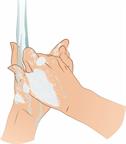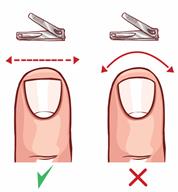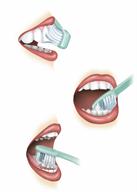Personal Hygiene: How to Take Care of Your Body
Personal hygiene means keeping your body clean. Doing this helps prevent infection and sickness. It also helps you avoid spreading germs to others.
Supplies needed:
-
Water, shampoo, soap, and a clean towel or air dryer.
-
Alcohol-based wipe, spray, or hand sanitizer, if soap isn't available.
-
Nail clippers.
-
Foot powders and a scrub brush for nails, if needed.
-
A comb or a brush.
-
A toothbrush, toothpaste, and floss.
-
A mouth rinse, if needed.
How to wash your hands
Germs get on your hands from the things that you touch. Washing your hands properly and often is a good way to prevent these germs from making you sick and spreading sickness to others.
When to wash your hands
Proper handwashing

- If you have running water:
Wet your hands.
Apply soap.
Rub your hands together for at least 20 seconds, covering all areas. This includes the backs of your hands, under fingernails, and between fingers.
Rinse your hands with clean, running water until all the soap is gone.
Dry your hands with a clean towel or paper towel, or let them air-dry. Do not use your clothing or a dirty towel to dry your hands.
- In a public restroom:
- If you don't have soap and water:
How to bathe properly
Bathing helps to prevent infections, body lice, and other problems. Follow these tips:
How to care for your fingernails
Keeping your fingernails clean and trimmed can prevent infection and fungus from growing. Follow these tips:
How to care for your feet
Keeping your feet clean and your toenails trimmed can help you avoid infection, irritation, and fungus from growing. Follow these tips:

Wash your feet daily with soap and water, if possible.
Wash your feet after activity and sweating.
Dry your feet after you wash them. This includes between your toes.
Trim your toenails straight across. Do not cut them too short to prevent ingrown toenails.
Keep your footwear clean. Wash your sneakers and clean the insides of your shoes often.
Think about using foot powders to lessen moisture in your shoes. This can help prevent fungus and other germs from growing.
Always wear shoes or flip-flops in shared spaces like public showers, pools, locker rooms, and training facilities.
How to care for your teeth and gums

Brushing and flossing your teeth, and rinsing your mouth, can help wash away bacteria that can lead to infection. Follow these tips:
Brush your teeth for 2 minutes, at least 2 times a day.
Floss your teeth at least once a day.
Brush your tongue daily. A tongue brush is often on the backside of a toothbrush.
Rinse with mouthwash as told by your dentist.
How to care for your hair
Caring for your hair can prevent head lice. Head lice are tiny insects that feed on the scalp and cause itching and irritation. Follow these tips:
Shampoo your hair regularly.
Brush your hair daily. Start at your scalp and move towards the ends of your hair.
Use your own comb or brush.
Remove loose hair from your combs and brushes.
Clean and disinfect your hair tools often.
Avoid head-to-head contact with others.
- Avoid sharing:
Hair styling tools.
Hair accessories like binders and headbands.
Headphones.
Hats, scarves, and earmuffs.
General tips
-
Never share personal hygiene items, such as towels, razors, deodorant, or toothbrushes.
-
Throw away disposable razors after a few uses.
-
Make sure that you use only your own items in shared public spaces, such as showers, locker rooms, and pools.
This information is not intended to replace advice given to you by your health care provider. Make sure you discuss any questions you have with your health care provider.


 Brushing and flossing your teeth, and rinsing your mouth, can help wash away bacteria that can lead to infection. Follow these tips:
Brushing and flossing your teeth, and rinsing your mouth, can help wash away bacteria that can lead to infection. Follow these tips: